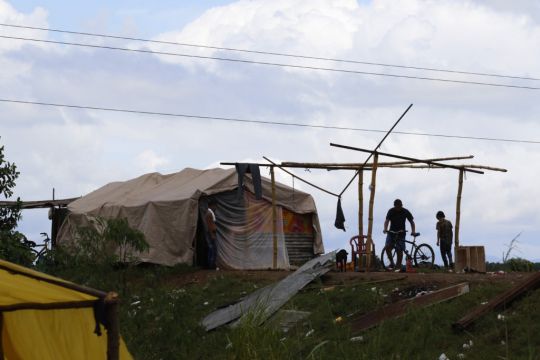Hurricane Iota has battered Nicaragua with screeching winds and pounding surf, forcing tens of thousands of people from their homes along the same stretch of the Caribbean coast that was devastated by an equally powerful hurricane two weeks ago.
The extent of the damage was unclear because much of the affected region was without electricity and phone and internet service, and strong winds hampered radio transmissions.
Preliminary reports from the coast included toppled trees and electric poles and roofs stripped from homes and businesses, but no deaths or injuries, said Guillermo Gonzalez, director of Nicaragua’s emergency management agency.
More than 40,000 people were in shelters.

Nicaragua vice president and first lady Rosario Murillo said a brother and sister, aged 11 and eight, had drowned in the community of La Pinuela while trying to cross the swollen Solera River. There were reports of others missing in the same area.
A day earlier, Iota intensified into a Category 5 storm, but it weakened as it neared the coast and made landfall with maximum sustained winds of 155mph.
The system came ashore about 30 miles south of the Nicaraguan city of Puerto Cabezas, also known as Bilwi.
By Tuesday afternoon, Iota had diminished to a tropical storm and was moving inland over northern Nicaragua. It had maximum sustained winds of 60mph and was spinning westwards at 12mph.
The storm is forecast to cross southern Honduras late on Tuesday.
Aid agencies struggled to reach their local contacts, and the government said in a statement that at least 35 towns in the east and north had no phone service.
Nicaragua’s telecommunications ministry said phone and broadband provider Columbus Networks was offline because of flooding in Bilwi.
As the storm moved westward, flooding became a top concern.

The Tola River topped its banks, and western Nicaragua, along the Pacific coast, was forecast to receive the most rain.
Nicaragua’s meteorology director, Marcio Baca, said areas where the soil was already saturated would receive 6in-7in of additional rain.
Iota came ashore just 15 miles south of where Hurricane Eta made landfall on November 3, also as a Category 4 storm.
Eta triggered flash floods and mudslides in parts of Central America and Mexico and killed more than 130 people.
“This hurricane is definitely worse” than Eta, Jason Bermudez, a university student from Bilwi, said as screeching winds preceded Iota’s arrival.
Many houses lost roofs, fences and fruit trees.
“We will never forget this year,” Mr Bermudez said.
Cairo Jarquin, emergency response project manager in Nicaragua for Catholic Relief Services, was in the area where Iota made landfall on Friday.
He said the primary concerns for people trying to survive after Eta were drinking water and shelter.
On Tuesday, he was unable to reach his local contacts on the coast.
Even before Iota hit Nicaragua, it scraped over the tiny Colombian island of Providencia, more than 155 miles off Nicaragua’s coast.
Colombian President Ivan Duque said one person was killed and 98% of the island’s infrastructure was “affected”.
Providencia is inhabited almost exclusively by the descendants of African slaves and British colonisers, who speak an English version of Creole as their native language.

The island has no direct flights to the continent, but it has become an increasingly popular tourist destination thanks to its quiet beaches and rich marine life.
On Tuesday, Colombian officials said they were sending a ship with 15 tons of aid to the island.
In the aftermath of Eta, Honduras has tens of thousands of homeless people.
The country reported 74 deaths and nearly 57,000 people in shelters, mostly in the north.
One of the hardest hit areas was La Lima, a San Pedro Sula suburb, that flooded when the Chamelecon river topped its banks.
Many people whose homes flooded moved to shelters or stayed with relatives.
Some stayed behind in an attempt to protect what few possessions remained. Authorities tried to force most of them to move to shelters ahead of Iota’s arrival.

On Monday, Wendy Guadalupe Contreras Paz, 34, was living under a cover with her four children and seven other relatives along a main boulevard in La Lima.
“I lost everything, I couldn’t take anything,” Ms Contreras said.
“But my mom and my grandmother have some things, and that’s why we’re living here, to be closer to the house and keep them from stealing the few little things they have left.”
Panama reported that one person had been killed and another was missing in its western indigenous autonomous Ngabe Bugle area near the border with Costa Rica.
Iota is the record 30th named storm of this year’s historically busy Atlantic hurricane season.
It is also the ninth storm to rapidly intensify this season, a dangerous phenomenon that is happening more often.
Such activity has focused attention on climate change, which scientists say is causing wetter, stronger and more destructive storms.
Iota developed later in the season than any other Category 5 storm on record, beating a November 8 1932 Cuba hurricane, said Colorado State University hurricane researcher Phil Klotzbach.
The official end of the hurricane season is November 30.







